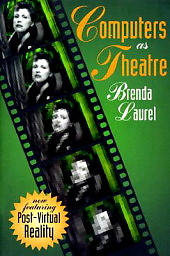Humans and computers are no longer separated by the 'interface', dressed up in its Macintosh desktop metaphor, but are joined in one 'designed experience'. To structure this practice we need a new conceptualisation for the computer, a new model. That model, Laurel argues, is theatre. It is expressed in the principles of dramatic theory.
Not all our uses of computers – like when I use a spreadsheet program or draw out money from an automatic cash machine - can be seen in such subjective terms. There are two broad categories of computer applications – the productive, enabling specific functions to be performed, and the ‘experiential' which is for creative applications and entertainment. Many applications span both, but Laurel proposes that even balancing our monthly accounts should be a pleasurable activity, dramatically structured like, as Nicholas Negroponte suggests, a scene from the play of your life.
When the computer is thought of as a tool, as it was by earlier engineers and programmers, we are unable to think beyond the technical workings of its internal machinery. The ‘metaphorical' interface developed at Xerox parc and introduced in the Apple Macintosh gives the user a ‘common ground' (the desktop metaphor) taking advantage of familiar objects, but restricts us to real-world representations that ignore the computer's full potential. Elements like the screen cursor have no real world equivalents anyway, and must be represented in terms of computer operations which are cognitively unnecessary for their use. The theatrical model (or meta-metaphor) encourages us to freely create new spaces for human/computer activities within the guidelines of dramatics. Think of the computer not as a tool, but as a medium.
Brenda Laurel studied and worked in theatre. She got into programming computer games early on as an extra source of income. Since then she has worked in all the well-known research laboratories, from Ohio State University to Atari to the Apple Computer Centre, mainly as a consultant in ‘interactive fantasy' and entertainment, and speaks regularly on the computer graphics circuit. This is her first authored book, written in an accessible and conversational style, but occasionally falling into that glib did-you-know? manner that American academics seem unable to avoid when writing their ‘popular book'.
For most of the first part of the book Laurel takes us pedantically through the basics of dramatic theory, using Aristotle's Poetics as our authority. Current deficiencies in interface design are seen in terms of a failure to observe the elements of dramatic structure such as enactment, pattern, character, action. In order to keep the theatrical conceptualisation as relevant as possible however, Laurel has to take on a massive recontextualisation task to allow for its deviations from the dynamics of computer interaction - most obviously that it is not for the benefit of an ‘audience' when we are using the computer and that the flexibility in engaging with the computer that Laurel wants to retain is excluded by the practice of working to scripts. This is the least successful part of the book.
What is left is the importance of ‘representing action', and theatre is recast as ‘mediated improvisation'. The functions of the computer now consist of a number of agents or ‘characters' of which the user is one, which interact and evolve into a performance. The importance of relating activities to a central ‘plot' is emphasised, which can be non-linear and context-dependent, but must always be neatly concluded after the usual build-up, climax and epilogue.
Basically the system functions like a playwright working with one bizarre constraint: one of the characters (the user) is walking around in the playwright's study, inserting actions and lines of dialogue at will, which must be incorporated into a pleasing dramatic whole.
All in all, there are not a whole lot of models in our current culture that can provide a promising model for such an open-ended new means of communication, playing and learning. If you're a passive receiver of something, then the obvious similarity is with tv; if you're an active participant then it must be a game. Is there something between the two, active and engaging but poetic, fluid and non-linear? Perhaps dancing is the most appropriate metaphor for the non-metaphorical interface, people interacting on the dance floor and interfacing with the dj, or even sport. But this would not preserve what Laurel considers the most important aspect of interactive activities, that meaning can only be embodied in dramatic characters, causal relations, actions and plots. Here we can perceive the limits of Laurel's approach - the difference between the theatrical model and, say, a dance model would be like the difference between cinema and mtv.
In the last section of the book, we consider the implications of the ultimate interactive fantasy, virtual reality (never far from any discussion of the future of computing and media). Laurel criticises the views of virtual reality guru Jaron Lanier and his idea of ‘post-symbolic communication' (is that a contradiction?)
in which when you're able to improvise reality (...) and when that's shared with other people, you don't really need to describe the world anymore because you can simply make any contingency (...) you can create any action. But for anyone else to understand what you're doing there needs to be some common language – Yes I can do ‘anything' in a virtual world, but how does the world respond? According to what principles? Dramatic principles are a start, although they are not the only strategy. But hopefully Laurel's contribution to the debate will mean that ‘designing your own reality' is not just a choice between Nietzsche and Timothy Leary.
